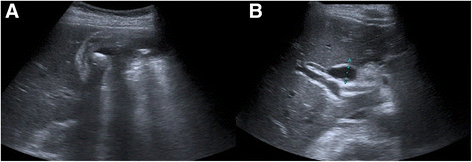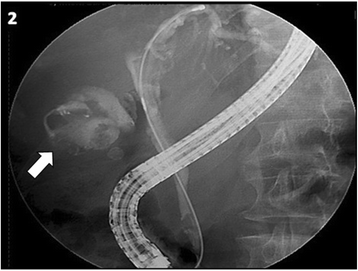Acute cholangitis in an old patient with Crigler-Najjar syndrome type II - a case report
- PMID: 26968162
- PMCID: PMC4788912
- DOI: 10.1186/s12876-016-0449-9
Acute cholangitis in an old patient with Crigler-Najjar syndrome type II - a case report
Abstract
Background: Crigler-Najjar syndrome (CN) is a very rare genetic disorder characterized by an inability to conjugate bilirubin. Contrary to CN type I, patients with CN II exhibit residual capacity to conjugate bilirubin and may present a normal life expectancy.
Case presentation: We report an unusual late diagnosis of CN type II in an 80-year-old female admitted with severe acute cholangitis. While the patient present typical clinical and radiologic signs of bile duct obstruction and cholangitis, her blood analysis showed severe unconjugated hyperbilirubinemia. Endoscopic retrograde cholangiopancreatography confirmed the diagnosis and allowed therapeutic intervention. The anatomopathologic examination of her gallbladder following cholecystectomy showed signs of chronic cholecystitis.
Conclusion: The risk of gallstone disease may be increased in patients with CN syndrome. While unusual, we alert to this curious and potential life-threatening presentation.
Keywords: Acute cholangitis; Choledocolitiasis; Crigler Najjar; Hyperbilirubinemia; Uridine diphosphate-glucuronosyl-transferase deficiency.
Figures
Similar articles
-
[Anesthetic and postoperative care of a patient with Crigler-Najjar syndrome type II].Masui. 1996 Mar;45(3):345-7. Masui. 1996. PMID: 8721137 Japanese.
-
Effect of phenobarbital on serum and biliary parameters in a patient with Crigler-Najjar syndrome, type II and acquired cholestasis.Dig Dis Sci. 1983 Aug;28(8):753-62. doi: 10.1007/BF01312568. Dig Dis Sci. 1983. PMID: 6872808
-
[Diagnosis and treatment of cholelithiasis].Ned Tijdschr Geneeskd. 2000 Jan 8;144(2):69-74. Ned Tijdschr Geneeskd. 2000. PMID: 10674105 Review. Dutch.
-
Genetic lesions of bilirubin uridine-diphosphoglucuronate glucuronosyltransferase (UGT1A1) causing Crigler-Najjar and Gilbert syndromes: correlation of genotype to phenotype.Hum Mutat. 2000 Oct;16(4):297-306. doi: 10.1002/1098-1004(200010)16:4<297::AID-HUMU2>3.0.CO;2-Z. Hum Mutat. 2000. PMID: 11013440 Review.
-
[The first case of Crigler-Najjar syndrome in the Czech Republic].Cas Lek Cesk. 1996 Feb 14;135(4):114-6. Cas Lek Cesk. 1996. PMID: 8625381 Czech.
Cited by
-
Perioperative Management of Patient with Esophageal Carcinoma and Crigler-Najjar Syndrome Type 2: A Case Report.Front Surg. 2022 Apr 27;9:889753. doi: 10.3389/fsurg.2022.889753. eCollection 2022. Front Surg. 2022. PMID: 35574557 Free PMC article.
-
Type II Crigler-Najjar syndrome: a case report and literature review.Front Med (Lausanne). 2024 May 9;11:1354514. doi: 10.3389/fmed.2024.1354514. eCollection 2024. Front Med (Lausanne). 2024. PMID: 38784231 Free PMC article.
References
Publication types
MeSH terms
Supplementary concepts
LinkOut - more resources
Full Text Sources
Other Literature Sources
Medical



